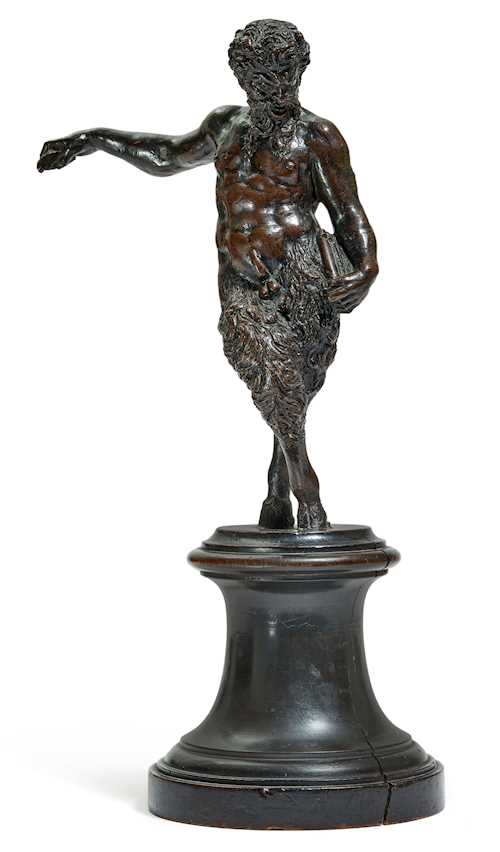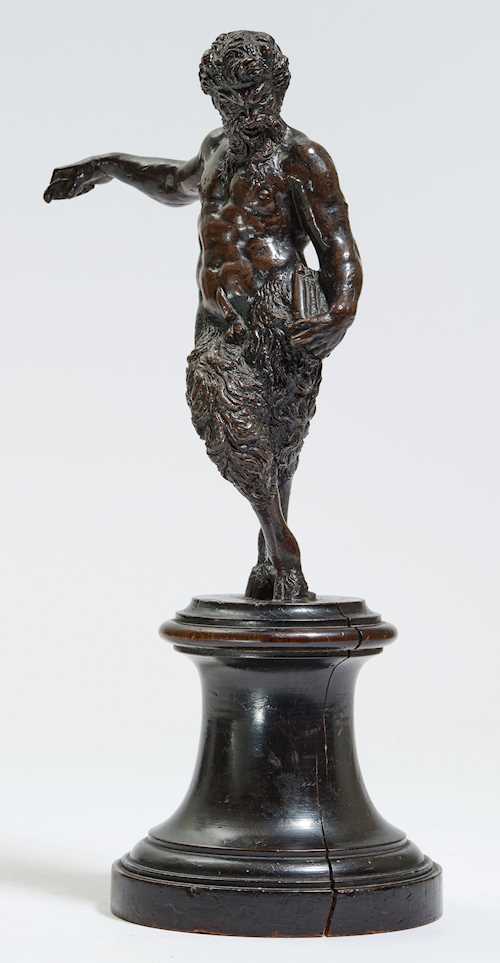
Lot 1026* - A210 Decorative Arts - Thursday, 19. September 2024, 02.00 PM
FIGURE OF A SATYR
Italy, Venice, 2nd half of the 16th century. Attributed to Andrea di Alessandri, called Il Bresciano (ca. 1550-1575).
Brown patinated bronze. Depicting a standing satyr with crossed hooves and outstretched right arm, holding a panpipe in his left hand. On an ebonized, retracted wooden base. The bottom of the base with Italian customs stamps dated April 9, 1965 and with auction labels and inventory number.
H without base 18 cm.
The bronze rubbed and with minor dents and scratches to the surface. The right hand trimmed. Minimal verdigris on the left leg. Wooden base with two larger cracks.
Provenance:
- Christie's auction, London, December 3, 1964, lot 72.
- Marcello Guidi, Florence, Italy, May 15, 1977.
- Baron Hans Heinrich Thyssen-Bornemisza (1921-2002), inv. no. K112B, purchased from the above dealer.
- By inheritance in the same family estate.
- Sotheby's London auction, July 10, 2014, lot 81.
- Private collection, Germany, acquired at the above auction.
The satyr, inspired by an antique model, was probably part of a more complex ensemble, probably a candlestick. Due to the dynamic pose, the figure would be unbalanced if it stood alone (see Charles Avery: Il Bresciano. Bronze-caster of Renaissance Venice (1524/25-1573). London 2020, p. 135). Referring to an almost identical sculpture offered by the Altomani & Sons gallery, Charles Avery also attributes our example to the Venetian bronze caster Andreas Bresciano (cf. Charles Avery ibid. p. 168, figs. 34-36). Another example of the same composition is known from the Louvre in Paris, but with a darker patina and a smoother surface treatment (inv. no. TH 122).
The bronze on offer is impressive not only for its expressiveness, but also for its prestigious provenance. It was owned by Baron Hans Heinrich Thyssen-Bornemisza and is illustrated in Charles Avery (op. cit. p. 135, fig. 12.19-12.2, cat. 45). As the son of the industrialist August Thyssen (1842-1926), the founder of the later Thyssen AG, Hans Heinrich Thyssen-Bornemisza inherited not only the industrial empire but also the top-class collection of paintings in the Villa Favorita in Castagnola. In 1993 the collection was purchased by the Spanish state and moved from Castagnola to what is now the Thyssen-Bornemisza Museum in Madrid.
Literature:
- Anthony Radcliffe et. al: The Thyssen-Bornemisza Collection. Renaissance and later sculpture, with works of art in bronze, London 1992, pp. 162-165, No. 24
- Charles Avery (ed.): Andrea di Bartolomeo di Alessandri detto il Bresciano “lavorator di gettar cose di Bronzo”: candelabri, satiri e battenti. In: L'industria artistica del bronzo del rinascimento a Venezia e nell'Italia settentrionale, Venice 2008, p. 243, fig. 22.
Provenance:
- Christie's auction, London, December 3, 1964, lot 72.
- Marcello Guidi, Florence, Italy, May 15, 1977.
- Baron Hans Heinrich Thyssen-Bornemisza (1921-2002), inv. no. K112B, purchased from the above dealer.
- By inheritance in the same family estate.
- Sotheby's London auction, July 10, 2014, lot 81.
- Private collection, Germany, acquired at the above auction.
The satyr, inspired by an antique model, was probably part of a more complex ensemble, probably a candlestick. Due to the dynamic pose, the figure would be unbalanced if it stood alone (see Charles Avery: Il Bresciano. Bronze-caster of Renaissance Venice (1524/25-1573). London 2020, p. 135). Referring to an almost identical sculpture offered by the Altomani & Sons gallery, Charles Avery also attributes our example to the Venetian bronze caster Andreas Bresciano (cf. Charles Avery ibid. p. 168, figs. 34-36). Another example of the same composition is known from the Louvre in Paris, but with a darker patina and a smoother surface treatment (inv. no. TH 122).
The bronze on offer is impressive not only for its expressiveness, but also for its prestigious provenance. It was owned by Baron Hans Heinrich Thyssen-Bornemisza and is illustrated in Charles Avery (op. cit. p. 135, fig. 12.19-12.2, cat. 45). As the son of the industrialist August Thyssen (1842-1926), the founder of the later Thyssen AG, Hans Heinrich Thyssen-Bornemisza inherited not only the industrial empire but also the top-class collection of paintings in the Villa Favorita in Castagnola. In 1993 the collection was purchased by the Spanish state and moved from Castagnola to what is now the Thyssen-Bornemisza Museum in Madrid.
Literature:
- Anthony Radcliffe et. al: The Thyssen-Bornemisza Collection. Renaissance and later sculpture, with works of art in bronze, London 1992, pp. 162-165, No. 24
- Charles Avery (ed.): Andrea di Bartolomeo di Alessandri detto il Bresciano “lavorator di gettar cose di Bronzo”: candelabri, satiri e battenti. In: L'industria artistica del bronzo del rinascimento a Venezia e nell'Italia settentrionale, Venice 2008, p. 243, fig. 22.
CHF 5 000 / 8 000 | (€ 5 150 / 8 250)
Sold for CHF 85 000 (including buyer’s premium)
All information is subject to change.





